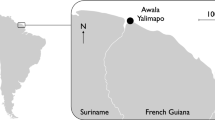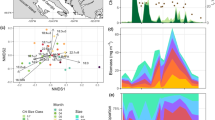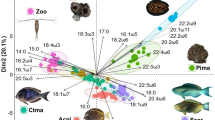Abstract
Short-term incubations in seawater containing H14CO3 - or 3H2O in place of the naturally predominant isotopes can yield highly radioactive preparations of living phytoplankton or zooplankton. Subsequent in situ incubation of these labelled organisms with the community from which they were taken results in the rapid transfer of radioisotope to those species which prey upon them. This technique has been employed to map a portion of a marine food web involving demersal zooplankton; experiments were conducted in summer and autumn on a coral reef and in a subtropical estuary. Similar results were obtained from these initial experiments at each study site during both seasons. Prey supplied as zooplankton (124 to 410 μm nominal diameter), which consisted mainly of Oithona oculata, was fed upon by zooplankton size classes ranging from 410 to 850 μm and containing amphipods, ostracods, cumaceans and polychaetes. In experiments employing labelled phytoplankton as prey a wide size spectrum was used (10 to 106 μm) in order to include representative samples of most of the available planktonic autotrophs as estimated by primary production measurements. In two separate experiments, only 7 out of 63 samples evidenced grazing of phytoplankton by demersal zooplankters. In contrast, labelled diatom auxospores, employed in one experiment as they constituted the most numerically abundant species in the water column, were found to be grazed upon in nearly half the samples examined.
Similar content being viewed by others
Literature Cited
Alldredge, A.L.: Discarded appendicularian houses as sources of food, surface habitats, and particulate organic matter in planktonic environments. Limnol. Oceanogr. 21, 14–23 (1976)
— and J.M. King: Distribution, abundance and substrate preferences of demersal reef zooplankton at Lizard Island Lagoon, Great Barrier Reef. Mar. Biol. 41, 317–333 (1977)
Baker, J.H. and L.A. Bradnam: The role of bacteria in the nutrition of aquatic detritivores. Oecologia (Berl.) 24, 94–104 (1976)
Brown, T.J. and J.R. Sibert: Food of some benthic harpacticoid copepods. J. Fish. Res. Bd Can. 34, 1028–1031 (1977)
Chang, B.D. and T.R. Parsons: Metabolic studies on the amphipod Anisogammarus pugettensis in relation to its trophic position in the food web of young salmonids. J. Fish. Res. Bd Can. 32, 243–247 (`975)
Chmyr, V.D.: Radiocarbon method of determining the production of zooplankton in a natural population. Dokl. Akad. Nauk SSSR 173, 201–203 (1967)
Finenko, Z.Z. and V.E. Zaika: Particulate organic matter and its role in the productivity of the sea. In: Marine food chains, pp 32–44. Ed. by J.H. Steele. Edinburgh: Oliver & Boyd 1970
Gerlach, S.A., D.K. Ekstrøm and P. H. Eckhardt: Filter feeding in the hermit crab Pagurus bernhardus. Oecologia (Berl.) 24, 257–265 (1976)
Silmer, R.W.: Free-floating mucus webs: a novel feeding adaptation for the open ocean. Science, N.Y. 176, 1239–1240 (1972)
Griffiths, F.B. and J. Caperon: Description and use of an improved method for determining estuarine zooplankton grazing rates on phytoplankton. Mar. Biol. (In press). (1979)
Hamner, W.M., L.P. Madin, A.L. Alldredge, R.W. Gilmer and P.P. Hamner: Underwater observations of gelatinous zooplankton: sampling problems, feeding biology, and behaviour. Limnol. Oceanogr. 20, 907–917 (1975)
Heinle, D.R., R.P. Harris, J.F. Ustach and D.A. Flemer: Detritus as food for estuarine copepods. Mar. Biol. 40, 341–353 (1977)
Johannes, R.E.: Phosphorus excretion and body size in marine animals: microzooplankton and nutrient regeneration. Science, N.Y. 146, 923–924 (1964)
—: Influence of marine Protozoa on nutrient regeneration. Limnol. Oceanogr. 10, 434–442 (1965)
Lenz, J.: On detritus as, a food source for pelagic filter-feeders. Mar. Biol. 41, 39–48 (1977)
Moriarty, D.J.W.: Quantification of carbon, nitrogen and bacterial biomass in the food of some penaeid prawns. Aust. J. mar. Freshwat. Res. 28, 113–118 (1977)
Pomeroy, L.R.: The oceans food web, a changing paradigm BioSci. 24, 499–504 (1974)
— H.M. Matthews and H.S. Min: Excretion of phosphate and soluble organic phosphorus compounds by zooplankton. Limnol. Oceanogr. 8, 50–55 (1963)
Porter, K.G.: Enhancement of algal growth and productivity by grazing zooplankton. Science, N.Y. 192, 1322–1333 (1976)
Sale, P.F., P.S. McWilliam and D.T. Anderson: Composition of the near-reef zooplankton at Heron Reef, Great Barrier Reef. Mar. Biol. 34, 59–66 (1976)
Seber, G.A.: The estimation of animal abundance and related parameters, 506 pp. London: Griffin 1973
Shushkina, E.A. and Yu. I. Sorokin: Radiocarbon determination of zooplankton production. Oceanology, Wash. 9, 594–601 (1969)
Smith, D.F.: Quantitative analysis of the functional relationships existing between ecosystem components. I. Analysis of the linear intercomponent mass transfers Oecologia (Berl.) 16, 97–106 (1974)
— and W.J. Wiebe: Constant release of photosynthate from marine phytoplankton. Appl. envirl Microbiol. 32, 75–79 (1976)
Sorokin, Yu. I.: On the role of bacteria in the productivity of tropical oceanic waters. Int. Revue. ges. Hydrobiol. 56, 1–48 (1971)
Wiebe, W.J. and L.R. Pomeroy: Microorganisms and their association with aggregates and detritus in the sea: a microscopic study. Memorie Ist. ital. Idrobiol. 29 (Suppl.), 325–352 (1972)
— and D.F. Smith: Direct measurement of dissolved organic carbon release by phytoplankton and incorporation by microheterotrophs. Mar. Biol. 42, 213–223 (1977)
Author information
Authors and Affiliations
Additional information
Communicated by G.F. Humphrey, Sydney
Rights and permissions
About this article
Cite this article
Smith, D.F., Bulleid, N.C., Campbell, R. et al. Marine food-web analysis: An experimental study of demersal zooplankton using isotopically labelled prey species. Mar. Biol. 54, 49–59 (1979). https://doi.org/10.1007/BF00387051
Accepted:
Issue Date:
DOI: https://doi.org/10.1007/BF00387051




